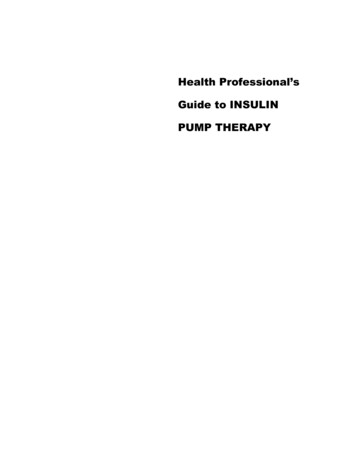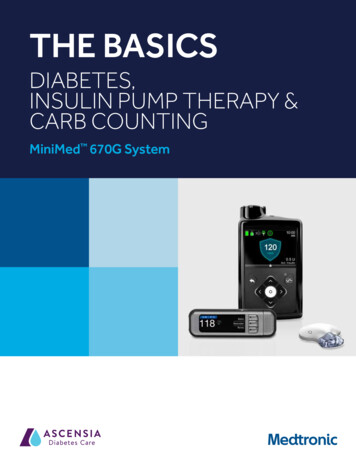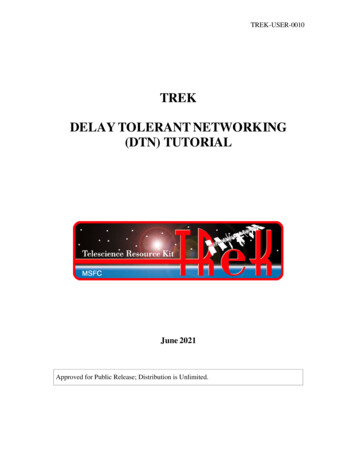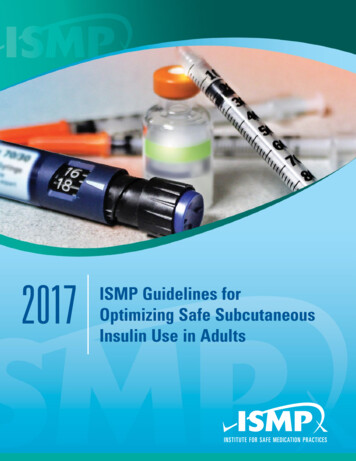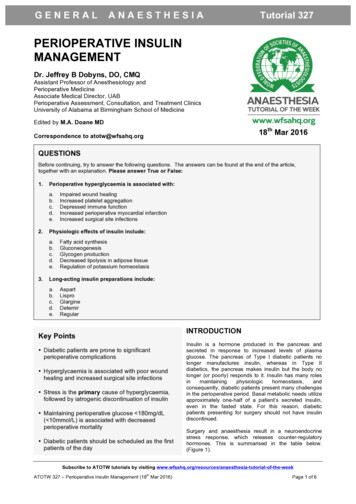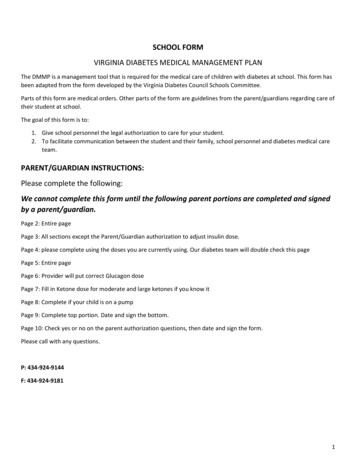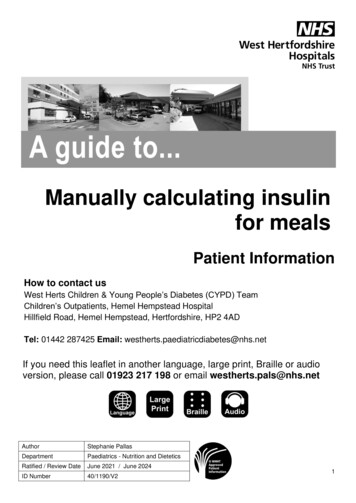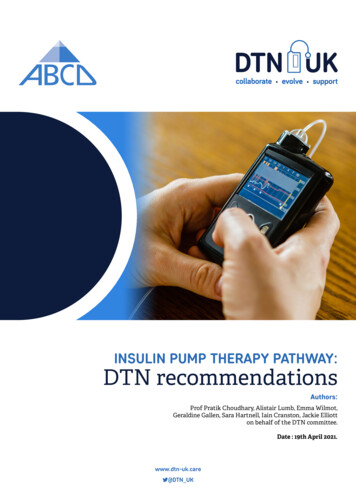
Transcription
INSULIN PUMP THERAPY PATHWAY:DTN recommendationsAuthors:Prof Pratik Choudhary, Alistair Lumb, Emma Wilmot,Geraldine Gallen, Sara Hartnell, Iain Cranston, Jackie Elliotton behalf of the DTN committee.Date : 19th April 2021.www.dtn-uk.care @DTN UK
INSULIN PUMP THERAPY PATHWAY: DTN RECOMMENDATIONS Version 1.0, 19th April 2021INSULIN PUMP THERAPY PATHWAY:DTN RECOMMENDATIONSAuthors:Prof Pratik Choudhary, Alistair Lumb, Emma Wilmot, Geraldine Gallen, Sara Hartnell, Iain Cranston, Jackie Elliotton behalf of the DTN committee.Date : 19th April 2021.Continuous Subcutaneous Insulin Infusion (CSII) using insulin pumps have been shown to improve glucosecontrol, reduce hypoglycaemia and improve the quality of life of people living with type 1 diabetes[ Pickup,2004] .NICE issued a TA in 2008 that made the following recommendations [NICE, 2008]:Continuous subcutaneous insulin infusion (CSII or 'insulin pump') therapy is recommended as a treatment optionfor adults and children 12 years and older with type 1 diabetes mellitus provided that: attempts to achieve target haemoglobin A1c (HbA1c) levels with multiple daily injections (MDIs) result in theperson experiencing disabling hypoglycaemia. For the purpose of this guidance, disabling hypoglycaemia isdefined as the repeated and unpredictable occurrence of hypoglycaemia that results in persistent anxietyabout recurrence and is associated with a significant adverse effect on quality of lifeOR HbA1c levels have remained high (that is, at 8.5% [69 mmol/mol] or above) on MDI therapy (including, ifappropriate, the use of long-acting insulin analogues) despite a high level of care.Following initiation in adults and children 12 years and older, CSII therapy should only be continued if it results in asustained improvement in glycaemic control, evidenced by a fall in HbA1c levels, or a sustained decrease in the rateof hypoglycaemic episodes. Appropriate targets for such improvements should be set by the responsible physician,in discussion with the person receiving the treatment or their carer.NICE TA151 does not specify high level of care, but does clarify that trained specialist team should providestructured education programs and advice on diet, lifestyle and exercise for people using CSIIThe DTN has been made aware that in many places across the UK, this has been interpreted as the need tocomplete a face to face structured education course. While all of us at DTN strive towards widespread access andavailability of high- quality structured education in flexible insulin therapy, we are aware of a number of challengesto this that prevent people with type 1 Diabetes (PwT1D) from accessing insulin pump therapy.Current challenges in access to CSII:1.2.3.4.5.6.7.8.Lack of clarity in defining “high quality of care”.Lack of access to accredited quality assured structured education such as DAFNE.Where courses are available, there is limited capacity. Analysis done by the London T1. Network found thateven if all courses were completely filled, the capacity for DAFNE just about covers the numbers of peoplewho will be newly diagnosed with Type 1 diabetes, leaving long waiting lists for others. The National DiabetesAudit report showed that 33.9% of services did not deliver approved structured education, and almost a fifth ofpeople with diabetes who are referred wait longer than 6 months. [ NDA, 2018]Some PwT1D are unable to access the education that is available due to limited timings, work or childcarecommitments, financial or social circumstances.Some teams only offer/prioritise education for those on a “pump pathway” without leaving adequate time toassess the effectiveness of self-management skillsSome PwT1D who have acquired skills in flexible insulin management – either self-taught or through follow-upvisits over time are forced to wait to do structured education courses for a long time when they may not need to.Some centres do not leave adequate time between completing the course and starting insulin pump therapy toassess the impact of the course.Some centres only offer a limited choice of insulin pumps.These challenges may be the reason why insulin pump uptake in the UK remains low compared to other westernEuropean counties.2
INSULIN PUMP THERAPY PATHWAY: DTN RECOMMENDATIONS Version 1.0, 19th April 2021DTN response to these challenges.DTN has developed the following guidance on defining high quality of care. The person with type 1 diabetes should be seen in specialist diabetes service. We recommend that this bedefined as a service that has:1. a defined type 1 diabetes lead2. a multidisciplinary core comprising medical, specialist nursing and dietetic team members who aretrained in and understand principles of flexible insulin therapy (i.e. carbohydrate counting, how to adjustinsulin:carbohydrate ratios and how to adjust insulin sensitivity factors and basal insulin in response toglucose data)3. experience and training in the use diabetes technology (e.g. completed ACADEMY training program)4. a regular multi-disciplinary team (MDT) meeting to review complex individual cases and review decisionsaround diabetes technology.5. All specialist diabetes services offering pump therapy should submit data to the National Diabetes Audit –so that on a national scale we can assess the effectiveness of pump therapy compared to MDI6. People with diabetes who have raised HbA1c ( 8.5% (68 mmol/mol) or disabling hypoglycaemia arereviewed frequently (4-6 times / year) (Choudhary, 2020) The person with diabetes should be using principles of flexible insulin therapy and receiving a “high level of care”1. For many PwT1D, this will mean that they will have completed an accredited structured education coursesuch as DAFNE.2. The PwT1D should have been reviewed by the MDT over the last 6-12 months (at least 3 times) withattempts made to optimise their therapy3. If face-to-face structured education is not possible, on-line education resources that support principles offlexible insulin therapy should be utilised - e.g.:» Remote DAFNE: https://www.DAFNE.nhs.uk» https://www.bertieonline.org.uk» https://mytype1diabetes.nhs.uk4. We do not believe that the “tick-box” of a structured education is in the “spirit” of the NICE guidance.Rather, the multi-disciplinary team should be supporting the person with diabetes to utilise skills offlexible insulin therapy.Key skills included in this should include: Measuring glucose pre-meal, at least 4 times a day: with either SMBG or Flash/CGMCarbohydrate counting (reviewed by a trained educator as part of the MDT)Bolusing before eating carbohydrate and using calculations that include carbohydrate counting, insulin:carbohydrate ratios and correction factors.Understanding the impact of exercise, illness and alcohol and the principles of adjusting therapy in responseto theseUnderstanding the principles of how to adjust basal and/or bolus insulin in response to glucose patternsExceptional circumstances: We recognise that for a proportion of PwT1D who meet the criteria of HbA1c 8.5%( 68 mmol/mol) and/or disabling hypoglycaemia, factors such as mental health or cognitive function amongothers may mean that despite efforts of the MDT, they are unable to acquire these skills. In these individuals,provided they have a high level of support from a skilled MDT, a “trial” of insulin pump therapy may beindicated where the MDT feel appropriate, with clearly defined with outcomes: These should be specified andagreed with the person with diabetes at the start, if the following “safety” criteria are met:1. Minimum of 2 glucose measurements / day over last 3 months.2. Has had training on sick day rules and ketone management3. Review against outcomes in 3 and 6 months.3
INSULIN PUMP THERAPY PATHWAY: DTN RECOMMENDATIONS Version 1.0, 19th April 2021Recommended DTN - Pump pathway1. All people with diabetes who meet NICE criteria of HbA1c 8.5% and/or disabling hypoglycaemia shouldbe considered for insulin pump therapy2. They should be offered high quality care as defined above.» The MDT should assess the skills described above – and if there are gaps in those skills these shouldbe addressed on an individual basis.» For many, this will mean referral to a structured education course» For some this may include 1:1 support for key skills such as dose adjustment or carbohydrate counting3. For some, on-line training or refresher courses may be adequate / appropriate.4. When referred to interventions such as structured education, this should be completed within thereferral-to-treatment target of 18 weeks.5. Once the intervention / education has been completed, unless there is clinical urgency (eg due to ongoing recurrent severe hypos), the team should review the individuals frequently (at least 2-3 times overthe next 6 months) to assess the impact of the intervention before being re-assessed by the MDT.6. If the MDT is satisfied that the person with diabetes has adequate skills, and despite review over 6months and appropriate changes to therapy continues to meet funding criteria for CSII – they should bereferred for CSII7. This referral should be measured against standard NHS 18-week referral to treatment8. This should include time taken to offer the person with diabetes adequate choice of insulin pump. TheDTN virtual showroom can support this.9. Teams may find it appropriate to work in groups or hubs to enable appropriate choice of insulin pumpand allow timely pump starts.4
INSULIN PUMP THERAPY PATHWAY: DTN RECOMMENDATIONS Version 1.0, 19th April 2021Recommended DTN - Pump pathwayHbA1c 8.5% (69.5 or70 mmol/mol) and/ordisabling hypoglycaemia MDT to assess skillsSkills assessmentq Measuring glucose pre-meal 4 or more /dayq Carbohydrate counting (reviewed by atrained educator as part of the MDT)q Bolusing before eating carbohydrate and usingcalculations that include carbohydrate counting,insulin: carbohydrate ratios and correction factors.q Understands the impact of exercise, illness and alcohol andthe principles of adjusting therapy in response to theseq Understands the principles of how to adjust basal and/or bolus insulin in response to glucose patternsq Sick day rules / ketone testingUsing skills adequatelyAdequate support from team Skills gapIndividualised plan to address skills gapq Structured education (eg DAFNE)q Virtual education› DAFNE online› Mytype1diabetes› Bertieonline› DTN education videosq 1:1 support and educationq Support group education› Exercise groups› Carb counting groups› Dose adjustment groups› Peer support groups› Psychological support› Motivational support Decision to start pump18 weeks [RTT]18 weeks [RTT] Re-assess at 3– 6 monthsdepending on the skills gap Start pump5
INSULIN PUMP THERAPY PATHWAY: DTN RECOMMENDATIONS Version 1.0, 19th April 2021Flow chart for commencing CSII remotelyPerson with diabetes meetscriteria for CSII/ person withdiabetes due pump upgradeDecision made at T1DMMDT to proceed with CSIIManufacturers: Virtual showroom DTN-UK videos DEVICE CHOICE MEDTRONIC OMNIPOD TANDEM ACCU-CHEK SOOIL YPSOMEDDevice choice and modeof training agreed withperson with diabetesDevice ordered fromcompany and sent directlyto person with diabetes Face to facetraining1. Access2. Availability3. Agreeable4. Technical literacyConsent completed byperson with diabetes andreturned to diabetes centreTime agreed with DSN/Industry representativePerson with diabetesattends diabetescentre for trainingPhysical/virtualattendance byindustry rep.Written confirmationof settings sent byindustry rep. to HCPHCP sends pre-determinedpump settings and personwith diabetes contactdetails to industry rep.Date arranged forvirtual trainingJoint training session withDSN and industry rep.Clinical checklistcompleted by DSN Virtual training(Group of 2)Technical checklistcompletedcompany rep.Technical trainingsession delivered(2 hours 30mins)DSN training sessiondelivered (30mins)Checklists completedby company rep/ DSN/person with diabetes Decision to proceedFollow up day3,5,7 with HCP6
3. experience and training in the use diabetes technology (e.g. completed ACADEMY training program) 4. a regular multi-disciplinary team (MDT) meeting to review complex individual cases and review decisions around diabetes technology. 5. All specialist diabetes services offering pump therapy should submit data to the National Diabetes Audit -



